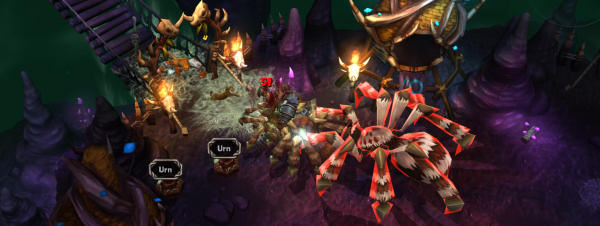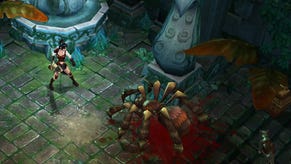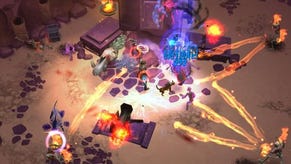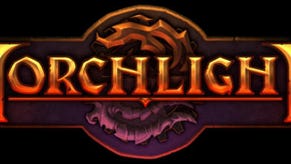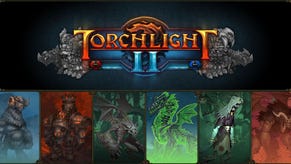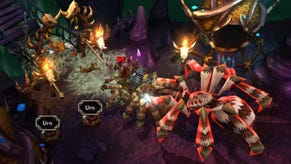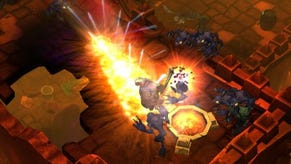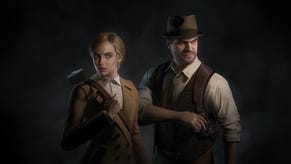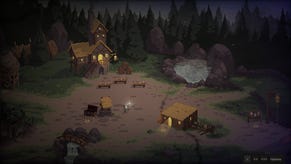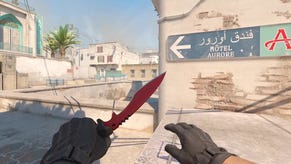Wot I Think: Torchlight
Runic's new action role-player Torchlight has occupied my week. Does their ultra-sleek and approachable dungeon crawler manage to find that sweet Diablo-shaped spot? Read on to find out wot I think.
My fingers hurt. I have done more clicking in the last week than in the rest of the year combined. I’ve been exploring the dungeons below the town of Torchlight for so long that I no longer know how to do anything else other than just click.
Torchlight’s biggest strength and weakness is its simplicity. The dungeon crawling follows the familiar themes of Diablo’s many children, built by the team behind Fate and Mythos. These people have pedigree (project lead Travis Baldree was in charge of both previous games, and the team includes ex-Blizzard types who worked on Diablo II). What they don’t have is an abundance of original ideas. The question is, does that matter?
Probably not. You pick one of three classes: Destroyer (Fighter), Vanquisher (Ranger), or Alchemist (Wizard), then choose whether your pet is a dog or a cat. There’s then an introduction to a story thinner than prosciutto ham, and the clicking begins. Each class has a unique set of three skill trees to select from, and each skill, along with magic spells learned (all classes can use magic proficiently) can be assigned to the hotkeys in the bar along the bottom of the screen. Left mouse is always your basic attack, and the right mouse is assigned by you as your secondary. (There’s some smart techniques to quickly reassign this right mouse attack mid-battle too.) If you can see it, attack it, then pick up its loot. And repeat. For the rest of time.
Torchlight follows the formula very faithfully. Almost minimally. Any twists to tradition are very subtle. What it instead focuses on is getting the core, idiotically engaging concept behind the dungeon crawler exactly right, and then makes it louder. It’s a ballistic game, exploding and erupting in frenzies of colour without pause, throwing wave after wave of raging enemies toward you.
The same attention to volume appears with its loot. It roars out of the screen like a geyser, bombarding you with weapons, armour, gold, potions and scrolls. You’ll be used to filling up your limited inventory quickly in such games, but not this quickly. Fortunately Torchlight has the rather spiffy idea (as shared with Fate) of giving your pet an inventory of the same size, letting him carry your spare content. Then when in the middle of a large dungeon, and too busy to use a portal scroll to head back to the above-ground shops, you can send your pet off with whatever he’s carrying to go sell it for you. It’s such a neat device that makes a welcome return. The deeper you go, the longer your pet will take to make the trip, and of course without him you’ll be slightly weaker in the fight.
There’s more to the pet. As well as being your constant buddy in battle, he can also perform his own magic. A pet has two ring slots and a pendant slot for the accompanying bonuses such jewellery bestows, but also two spell slots. Any magic you can use, he can use. This means you can set him up with buffs or attack extras which he’ll fire off independently, but far more interesting is to take advantage of the “pet” spells. With the right spell bought or found you can conjure up an extra helper, say a skellington, who will join your gang for a limited time. But rather than worry about that for yourself, assign this to your pet. As soon as my Destroyer got into a fight my faithful cat, Dexter, would generate a skeleton to join in. In fact, play an Alchemist and you can create yourself your own army of followers, created by both you and your pet.
I mentioned before about going deeper. Torchlight isn’t big on destination choice. The core game is set in one enormously deep set of levels, with faint scraps of side quests to explore. The tissue-thin story is something about chasing down a Master Alric, who has been corrupted by a substance known as Ember, found in the minds beneath the town of Torchlight. As you descend through the levels the environments change, as do the enemies, creating some sense of variety. And as you go you’re told by the story that the ‘blight’ caused by Ember has affected you too. But 33 levels down I’m still not what that has to do with anything.
There’s a few side-quests you can take on. Elsewhere in Torchlight is a man who’ll open portals to various areas in another storyline about helping him realise the mysteries of a book he owns. You can also buy mini-quests from merchants in the form of maps. However, both of these repurpose environments from the main quest, and a couple of levels into any of them I honestly couldn’t remember which I was doing. Because, after all, it really doesn’t matter. It’s all about the clicking.
However, I do wish they’d at least pretended there was a greater sense of going somewhere. Every few floors down this vast shaft sees the environments completely changed – perhaps it’s ruins overgrown with vegetation switching over to Dwarven chambers. If they’d only had you return to Torchlight and then use a different portal or passageway to reach this new location, it would have felt more substantial, and less claustrophobic. It doesn’t matter how much variety there is – I’m still on floor 33 of the same level after 12 hours, and it makes the game seem oddly small. Compare it to, say, Titan Quest, and that horizontal spread let a game with no more detail feel so much more expansive.
The other completely unnecessary failing is the setup of the quests. I don’t need to actually be doing anything different – I just need to be told I am. But Torchlight makes no effort to offer this variety either. Throughout you’re only ever looking for specific chunks of Ember for one wizard dude, killing certain bosses for a strange robot chap, and battling ever deeper for the girl who keeps blurting the story at you. And that’s it. No, “Go to randomly generated dungeon X to recover my mum’s lost reading glasses,” then, “Go to randomly generated dungeon Y to replace this book in the magic library.” Which I rather missed.
The looterfall begins to make more sense the farther you get. At first new equipment comes so thick and fast that you’re never given a chance to grow attached to anything, constantly upgrading weapons and armour after every fight. However, later on it finds that sweet spot where you find yourself weighing up the advantages of varying bonuses against upgrades you may have made to a faithful axe. Both weapons and armour can carry enchantments and gems, each augmenting them usefully. Rarer loot will come with enchantments, but you can add some or more via the enchanter in the town. (There’s a hefty charge, and the gamble that it might not work, or even undo previous enchantments.) Again items may come with one or two sockets in which gems can be placed – if not an enchantment might add slots. You find gems as you explore the dungeons, and lower grade jewels can be combined with identical types to upgrade them. Eventually you’ll have a weapon or two, and perhaps some boots or a helmet that you’ve enchanted to the eyeballs and loaded with your finest gems. Parting with them can be a sad moment, which is precisely how I want games like these to make me feel.
Torchlight’s gorgeous design (a more fun, more sleek WoW-style, emphasising on colour) and constant explosive detail ensures it’s always interesting to look at, even if it’s not always interesting to play. Three or four levels into a sequence of dragons and demons I’m finding myself a little fed up of fighting the same enemies still, and looking forward to the next shift in environment. The only problem is, I do at this point, 12 hours in, start to wonder if there’s enough incentive to keep going. I think it’s here that the dismissive narrative reveals its failing – I’ve been teased with fighting Alric so many times now than I’ve given up on it happening, and it’s been a while since any drops have competed with my own augmented equipment. Without a sense of purpose the otherwise very entertaining, if somewhat mindless, game might be running out of steam.
The game nails that hoary old cliché of, “I’ll just play it for thirteen picoseconds,” and then emerging four thousand years later to discover the world has been destroyed in a brutal nuclear war and all the food in your house has become sentient and set up a colony in your kitchen. And the focus on the process of battling and loot-sorting I found it one of those ideal games that lets you be completely engaged in all it offers and also listen to podcasts. My choice for Torchlight: RadioLab. I couldn’t recommend it highly enough, letting Torchlight occupy one section of your brain while witty and informative education goes into another. In fact, as much as I may now have found myself growing a little weary of it, for the last two or three days I’ve felt delighted that I’ve been able to absorb both at the same time in such an enjoyable way.
There’s two other things that must be mentioned. First is the price. It’s £15 on Steam, Direct2Drive and elsewhere, and only £12 if bought directly from Runic, which is absolutely spot on perfect. And second, and even more significantly, is the customisation. In the next day or so the editor will be released, which we’re told will let you easily create your own levels, texture packs, and so on. It also lets you mod every detail of the game, tweaking loot drops, skins, animations, music, the UI…
It does want for horizontal spread and a greater sense of purpose for playing. But as a pure mechanic it aces the dungeon crawler, and does it in an ultra-bright, cheerful way. At such a smart price, and with so much modding potential, it seems well worth it.
Edit: People in the comments have reminded me of something I had intended to mention - the difficulty levels. I started the game on Normal (as one always does for a review), but wished I'd gone for Hard. It's a shame you can't change level during the game, once you've learned where the difficulty is pitched, but when I play it again with a different class it will definitely be at least on Hard.






